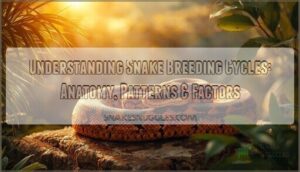This site is supported by our readers. We may earn a commission, at no cost to you, if you purchase through links.

When your snake stops eating, tilts its head skyward in an unnatural stare, or loses the ability to right itself, you’re likely witnessing the early stages of Inclusion Body Disease—a viral infection with a devastatingly clear endpoint.
IBD, caused by a reptarenavirus, attacks the central nervous system of captive boas and pythons with relentless progression. The snake inclusion body disease prognosis leaves little room for optimism: mortality rates approach 100%, and no cure exists.
What makes this disease particularly insidious is its variable timeline—some snakes decline within weeks while others linger for months—and the presence of asymptomatic carriers that silently spread the virus throughout collections.
Understanding the expected disease course, recognizing the factors that influence survival time, and knowing when supportive care transitions to humane intervention can help you navigate one of the most challenging diagnoses in reptile medicine.
Table Of Contents
Key Takeaways
- Inclusion Body Disease, caused by a reptarenavirus, carries a near-100% mortality rate in symptomatic boas and pythons with no cure available, making euthanasia the only humane endpoint once neurological decline becomes severe.
- Disease progression varies dramatically by species and age—juvenile pythons often die within weeks of symptom onset while adult boas may survive months to years, though asymptomatic carriers can shed virus for extended periods without showing clinical signs.
- Diagnosis requires tissue biopsy combined with RT-PCR testing rather than blood smears alone, as inclusion body detection rates in blood reach only 34% in boas and are rarely positive in pythons.
- Strict biosecurity measures including six-month quarantine periods, mite control, and disinfection with sodium hypochlorite are essential to prevent transmission, since the virus spreads through direct contact, contaminated secretions, and snake mites acting as vectors.
What is Snake Inclusion Body Disease?
Inclusion Body Disease is a fatal viral infection that affects captive boas and pythons, caused by an arenavirus first identified in the United States during the 1970s.
The disease progressively attacks the snake’s central nervous system and immune function, making it one of the most serious health threats in reptile collections.
Understanding what IBD is—from its viral origins to the species most at risk—gives you the foundation to recognize this disease and protect your collection.
Definition and Causative Agent
Inclusion Body Disease (IBD) is a fatal viral infection primarily found in captive boas and pythons. The culprit is a novel arenavirus classified in the Reptarenavirus genus—not a retrovirus, despite what you might hear. This virus spreads through direct contact, contaminated secretions, bite wounds, and snake mites acting as transmission vectors.
IBD is invariably fatal because it’s caused by retrovirus infection. All boid snakes are susceptible, making host susceptibility a critical concern for your collection.
History and Discovery
Your understanding of IBD begins with its discovery in the 1970s United States, where early identification centered on captive pythons and boas. For nearly two decades, researchers suspected a retrovirus as the viral etiology, but diagnostic evolution in the 2000s revealed arenaviruses instead.
This reshaped our understanding of the disease’s geographic distribution and confirmed IBD’s historical impact on captive collections worldwide. Scientists at UCSF identified the novel virus’s cause, paving the way for better diagnostics.
Commonly Affected Snake Species
Now that you know how this disease was identified, let’s look at which snake species you’re most likely to encounter it in. Boid snakes—particularly boa constrictors and members of the python family—face the highest risk. Species prevalence varies dramatically based on age and captivity conditions.
Here’s what geographic distribution studies reveal:
- Boa constrictors show infection rates between 16.5% and 34% in captive populations
- Burmese pythons, reticulated pythons, and ball pythons demonstrate high python susceptibility
- Australian pythons, colubrids, and even palm vipers have documented cases
Risk factors include crossbreeding, poor quarantine, and mite exposure.
Clinical Signs and Disease Progression
Recognizing the signs of IBD early can make a real difference in how you manage your snake’s care. The disease doesn’t announce itself all at once—it generally starts with subtle neurological changes before moving into more obvious physical symptoms.
Let’s walk through what you’ll actually see as the disease progresses, from those first warning signs to the complications that can develop over time.
Early Neurological Symptoms
Neurological symptoms often emerge as the first warning signs, with head tremors, stargazing, and torticollis appearing early in your snake’s disease course. You’ll notice problems with the righting reflex—your snake can’t flip itself over—and neural inclusions in brain tissue drive this neurological decline.
Pythons generally show severe signs sooner than boas, with paralysis onset varying from weeks to months depending on species and individual progression.
Gastrointestinal and Physical Manifestations
Before neurological signs take hold, your snake’s digestive system often bears the first blow. Regurgitation and lack of appetite signal GI dysfunction early in disease progression, particularly in boas. Watch for these prognostic indicators:
- Persistent regurgitation leading to dehydration
- Weight loss exceeding 10% of body weight
- Poor appetite lasting weeks to months
- Visible wasting and lethargy
These physical changes reflect systemic infection and poor prognosis.
Secondary Infections and Complications
As your snake’s immune system weakens from reptarenavirus infection, secondary infections become a major threat. Bacterial infections, such as pneumonia and stomatitis, along with fungal complications, frequently develop in immunosuppressed snakes. These opportunistic infections significantly increase morbidity rates and often prove fatal, rather than the virus itself. Studies indicate that approximately 25% of IBD-positive boas develop significant comorbidities during follow-up.
| Infection Type | Common Manifestations |
|---|---|
| Bacterial Infections | Pneumonia, stomatitis, granulomas |
| Fungal Complications | Respiratory and skin infections |
| Protozoal Infections | Gastrointestinal parasitism |
| Mixed Infections | Multi-organ system involvement |
| Preventative Measures | Quarantine, hygiene, monitoring |
Diagnosis of Inclusion Body Disease
Diagnosing IBD isn’t something you can do at home just by watching your snake’s behavior. Your veterinarian will need to collect specific samples and run specialized tests to confirm whether your snake has this disease.
Let’s look at how veterinarians gather evidence and rule out other conditions that might mimic IBD’s symptoms.
Sample Collection and Interpretation
Laboratory testing for IBD requires strategic sample collection from your snake. Blood samples offer varying sensitivity—blood smear analysis detects inclusions in 34% of boas but rarely in pythons.
The best diagnostic practice remains tissue biopsy from liver, kidney, or esophageal tonsil. Your veterinarian will use RT-PCR tests on properly stored samples, though asymptomatic viral carriage complicates interpretation.
Organ tissue samples provide the most reliable confirmation.
Differential Diagnosis and Disease Confirmation
Your veterinarian faces a diagnostic puzzle because meningitis mimicry and protozoal infections share neurological signs with inclusion body disease.
Laboratory testing for IBD combines histopathology with RT-PCR—the preferred method for detecting asymptomatic carriers. Inclusion variability means blood smears alone won’t suffice. PCR sensitivity reaches down to 40 viral copies, while necropsy confirms tissue-based inclusions.
This integrated approach prevents misdiagnosis and controls outbreaks in your collection.
Prognosis for Snakes With IBD
The prognosis for snakes diagnosed with IBD is unfortunately grave, and understanding what lies ahead can help you make informed decisions about your snake’s care.
Once clinical signs appear, the disease follows a predictable but variable course that depends on several factors. Let’s examine the mortality rates, disease progression, and what influences how long affected snakes usually survive.
Mortality Rates and Disease Course
Once clinical signs appear, you’re facing a near-certain outcome—mortality rates approach 100% in symptomatic snakes. Disease progression varies dramatically: juvenile pythons often succumb within weeks, while adult boas may survive months to years despite neurological symptoms.
Once clinical signs appear, mortality rates approach 100%, though survival varies from weeks in juvenile pythons to months or years in adult boas
Asymptomatic carriers complicate matters, as they can shed the virus without showing clinical signs. Secondary infections like pneumonia generally hasten decline, making prognostic indicators grim once symptoms emerge.
Factors Affecting Prognosis (Species, Age, Comorbidities)
Your snake’s prognosis hinges on three critical variables: species susceptibility, age influence, and comorbidity impact. Pythons deteriorate faster than boas, while juveniles face more acute courses than adults. Age-related infection rates climb from 14.3% in juveniles to 21.3% in adults.
Secondary infections—osteomyelitis, pneumonia, stomatitis—compound immune suppression in snakes, accelerating decline. Environmental stressors like mites worsen neurological symptoms in snakes, while genetic predisposition and poor body condition further compromise outcomes.
Expected Survival Times
Once you understand the factors at play, survival times become clearer. Pythons and juveniles often die within weeks of symptom onset—an acute course that leaves little room for supportive care.
Adult boas can survive months or even years, though the prognosis of IBD in snakes remains uniformly fatal.
Some act as asymptomatic carriers for years without obvious disease, complicating collection management and humane euthanasia decisions.
Supportive Care and Management Options
While there’s no cure for IBD, you can still take steps to ease your snake’s suffering and maintain quality of life for as long as possible. Your focus should shift to managing symptoms, preventing complications, and knowing when humane intervention becomes necessary.
The following approaches represent the most effective ways to support an IBD-positive snake through this progressive disease.
Palliative Treatments and Symptom Relief
Since there’s no cure for IBD, your focus shifts to keeping your snake comfortable. Palliative treatment includes assisted feeding if your snake won’t eat, fluid therapy with fluids and electrolytes to prevent dehydration, and antibiotic use for secondary infections.
Ideal temperature control and soft substrates help minimize injury from neurological clinical signs. Pain management remains limited, though supportive care can extend quality life for months.
Prevention of Secondary Infections
Your snake’s weakened immune system makes it vulnerable to secondary infections, so your biosecurity measures matter immensely. Here’s what helps reduce that risk:
- Maintain strict quarantine protocols for at least 6 months when introducing new snakes
- Use sodium hypochlorite (bleach) for disinfection methods against reptarenavirus
- Control environmental conditions by keeping humidity below 60%
- Apply antibiotic use based on culture results from respiratory samples
- Implement biosecurity measures including separate cages and mite control
Euthanasia and Humane Considerations
When supportive treatment no longer maintains quality of life, euthanasia becomes the most humane option. Veterinarians generally use injectable anesthetics followed by confirmation of death—a process that respects welfare considerations while addressing disease control needs. Post-euthanasia, your snake should undergo necropsy to confirm the diagnosis. The prognosis of IBD in snakes makes this difficult decision an ethical necessity for preventing suffering.
| Decision Factor | Clinical Indicator | Recommendation |
|---|---|---|
| Neurological decline | Paralysis, disorientation | Consider euthanasia |
| Feeding status | Persistent regurgitation | Evaluate quality of life |
| Secondary infections | Unresponsive to antibiotics | Humane methods warranted |
| Disease transmission | Multiple snake household | Isolate or euthanize |
| Progressive symptoms | Weeks without improvement | Consult exotic vet |
Frequently Asked Questions (FAQs)
Can IBD be transmitted to other reptile species?
As reptile keepers know, viral transmission across species often hits biological walls—and IBD is no exception.
Reptarenavirus infection in reptiles remains strictly limited to boas and pythons, with no confirmed cases in lizards, turtles, or other non-snake species.
Is there ongoing research for IBD vaccines?
Yes, vaccine trials show promise. Experimental studies demonstrate 75% protection using inactivated viral preparations, with antibody response duration extending 74 days post-vaccination.
However, no commercial IBD vaccine exists yet—research continues toward future development.
How long should quarantine periods last for snakes?
Think three months is plenty? You’re rolling the dice. Quarantine protocols demand at least 90 days, ideally extending to six months for boas and pythons—asymptomatic carriers make transmission prevention a waiting game.
What biosecurity measures prevent IBD in collections?
You’ll need quarantine protocols lasting at least six months, strict mite control, regular diagnostic screening, dedicated cleaning tools, and sourcing snakes only from tested, IBD-negative collections to protect your animals effectively.
Can asymptomatic snakes transmit IBD to others?
Ironically, your healthiest-looking snake might be the biggest threat. Asymptomatic carriers shed virus through urates, feces, and shed skin—enabling transmission of IBD via mites, direct contact, and shared equipment despite their carrier state.
Conclusion
The moment your snake exhibits that first stargazing episode, the clock starts ticking on decisions you’ll need to make. The snake inclusion body disease prognosis eliminates false hope—this isn’t a battle you’ll win, but one where your choices determine your snake’s dignity in decline.
Document symptoms, consult your veterinarian early, and recognize when quality of life crosses the threshold where compassion demands letting go.
- https://pmc.ncbi.nlm.nih.gov/articles/PMC7051093/
- https://www.morrisanimalfoundation.org/article/researchers-develop-new-test-better-understanding-deadly-infection-boas-and-pythons
- https://wildlifehealthaustralia.com.au/Portals/0/ResourceCentre/FactSheets/Reptiles/Reptarenavirus_and_IBD_in_Australian_snakes.pdf
- https://www.vetlexicon.com/exotis/reptiles/parasitology/articles/inclusion-body-disease/
- https://en.wikipedia.org/wiki/Inclusion_body_disease












